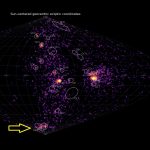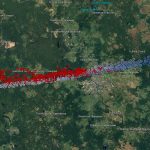By Milan Kalina
Abstract: An Earth grazing meteoroid has been recorded by cameras of the Global Meteor Network on 2020 September 15, 19h37m UT. The trajectory and the orbit could be determined, the meteoroid had an orbit type of an undiscovered long periodic comet but no meteor shower association could be proven.
1 Introduction
On 2020 September 15th, at 19h37m UTC, Central European GMN cameras in Czech Republic, Germany (see Figure 1) and Poland registered an Earth grazer. The automatic procedure reduced only the camera data for the RMS systems CZ0002 and PL0001. A manual analysis was required to include the German camera data. Grazing meteor trajectories have peculiar geometrics which cannot be handled by the automated procedures.
Typically for an Earth grazing meteor the path length is exceptionally long and the ending point can be considerably higher than the point of closest approach relative to the surface of the Earth due to the curvature of the Earth. Such unusual meteor geometrics require a careful manual approach. Earth grazers are rather rare events, but recorded every now and then by all major camera networks.
2 Results
It was not a very bright, but a long duration event caused by a meteoroid, which entered the atmosphere at a height of 122 km with a very low entry angle above northern Czech Republic, and it left the atmosphere at the height of 121 km over southern Germany, close to the Swiss border (Figure 2).
During its duration of 7.6 s, the object travelled more than 520 km, thanks to a very high initial speed of about 68 km/s. The point of closest approach with the lowest height relative to the Earth surface did not get below 116 km. Photometry on the visible trajectory has been calculated along the whole path. A small portion with inconsistent data (CZ0002) obtained at a low elevation angle, affected by tropospheric scatter and distant clouds was removed.
An apparent correlation between the peak height and peak magnitude has been obtained (Figure 3).
Figure 1 – The Earth grazer at 2020 September 15, at 19h37m19s UT registered by RMS camera DE0008 in Germany.

Figure 2 – The positions of the three GMN camera stations and the ground plot of the trajectory of the Earth grazer.

Figure 3 – The height (km) and photometry (absolute magnitude) of the grazing meteor versus time. The curved trajectory reflects the curvature of the Earth.
The GMN trajectory calculation based on data from 4 cameras, which covered the entire trajectory also revealed the origin, most probably a long periodic comet fragment from a yet undiscovered parent body (Figure 5).
The following radiant position (Figure 4), velocity and orbit has been obtained for this meteor:
- λʘ= 173.130915°
- αg= 58.06 ± 0.02°
- δg= +20.62 ± 0.01°
- vg= 67.55 ± 0.02 km/s
- v∞= 68.45 ± 0.02 km/s
- a= ∞ AU (hyperbolic)
- q = 0.60469 ± 0.0006 AU
- e= 1.0073 ± 0.0008
- i= 179.15 ± 0.03°
- ω= 257.97 ± 0.08°
- Ω= 172.976 ± 0.004°
- Π= 70.95 ± 0.00°
The velocity uncertainty is underestimated, probably as much as one order of magnitude. The uncertainty margin for the eccentricity makes the meteor’s orbit hyperbolic, which is most certainly not the case.
A check in the IAU MDC working list of meteor showers resulted in no matching known shower, hence this event should be classified as a sporadic meteor. A visual check of the meteor shower list resulted in a poorly documented possible meteor shower listed as the 14 Aurigids (FAR#608). Although the D criteria reject any likely association, this shower has a retrograde orbit with a similar perihelion distance, high eccentricity and comparable velocity, but recorded 21 days later from a radiant roughly 20° east in Right Ascension and 10° north in declination.

Figure 4 – The Monte Carlo geocentric velocity versus the radiant position.

Figure 5 – The plot with the fit residuals for the entire length of the trajectory.

Figure 6 – The orbit plotted relative to the planets.
Acknowledgment
The author thanks the camera operators Jürgen Dörr and Przemek Naganski and Denis Vida for his advices.
The author used the data of the Global Meteor Network which is released under the CC BY 4.0 license.







Given the tools and proper guidance, citizen scientists can make a large contribution and help document rare events such as earthgrazer. This one was observed on Sept 15 over Czechia and S Germany by 6 #globalmeteornetwork cameras. @westernuSpace @IMOmeteors